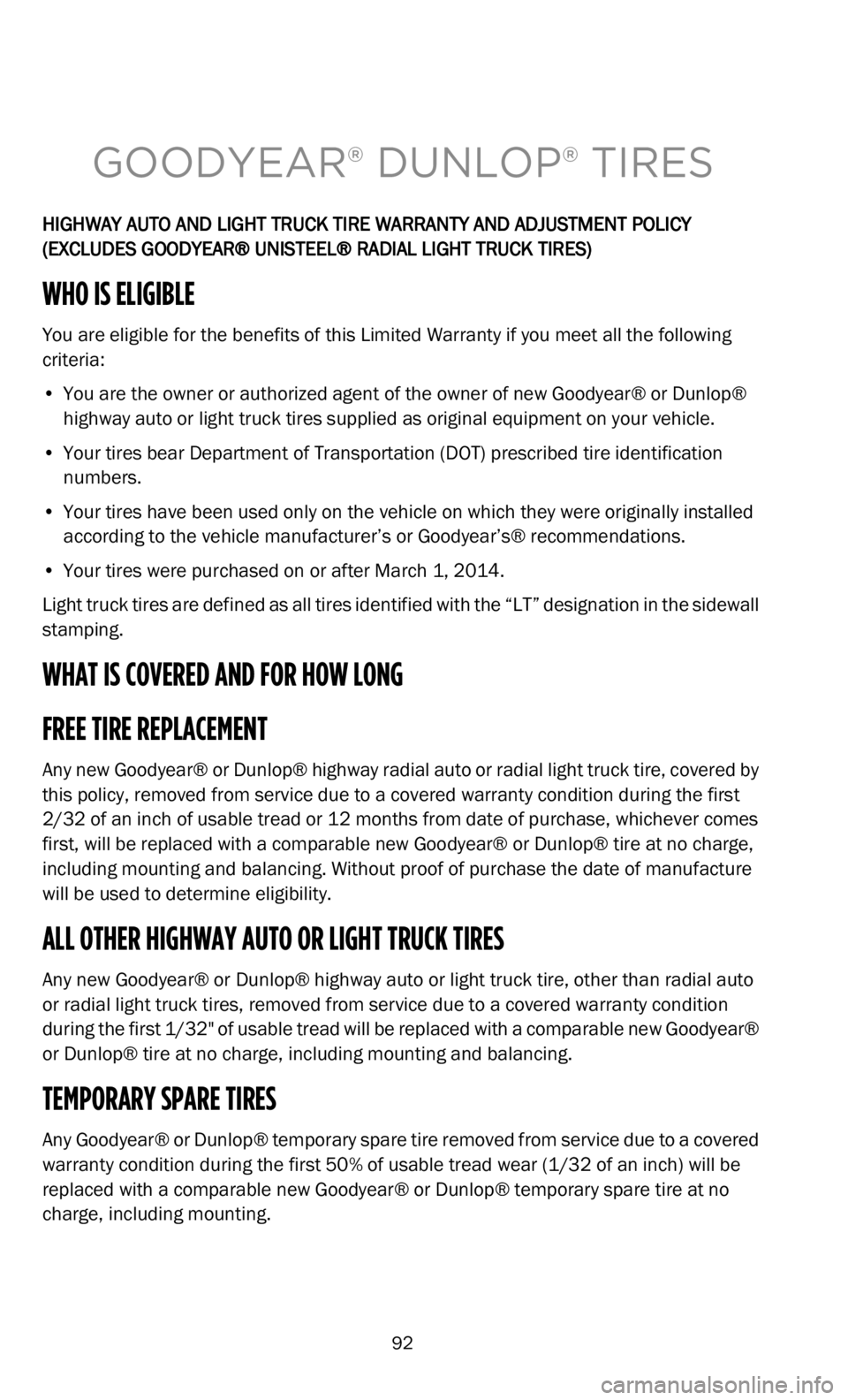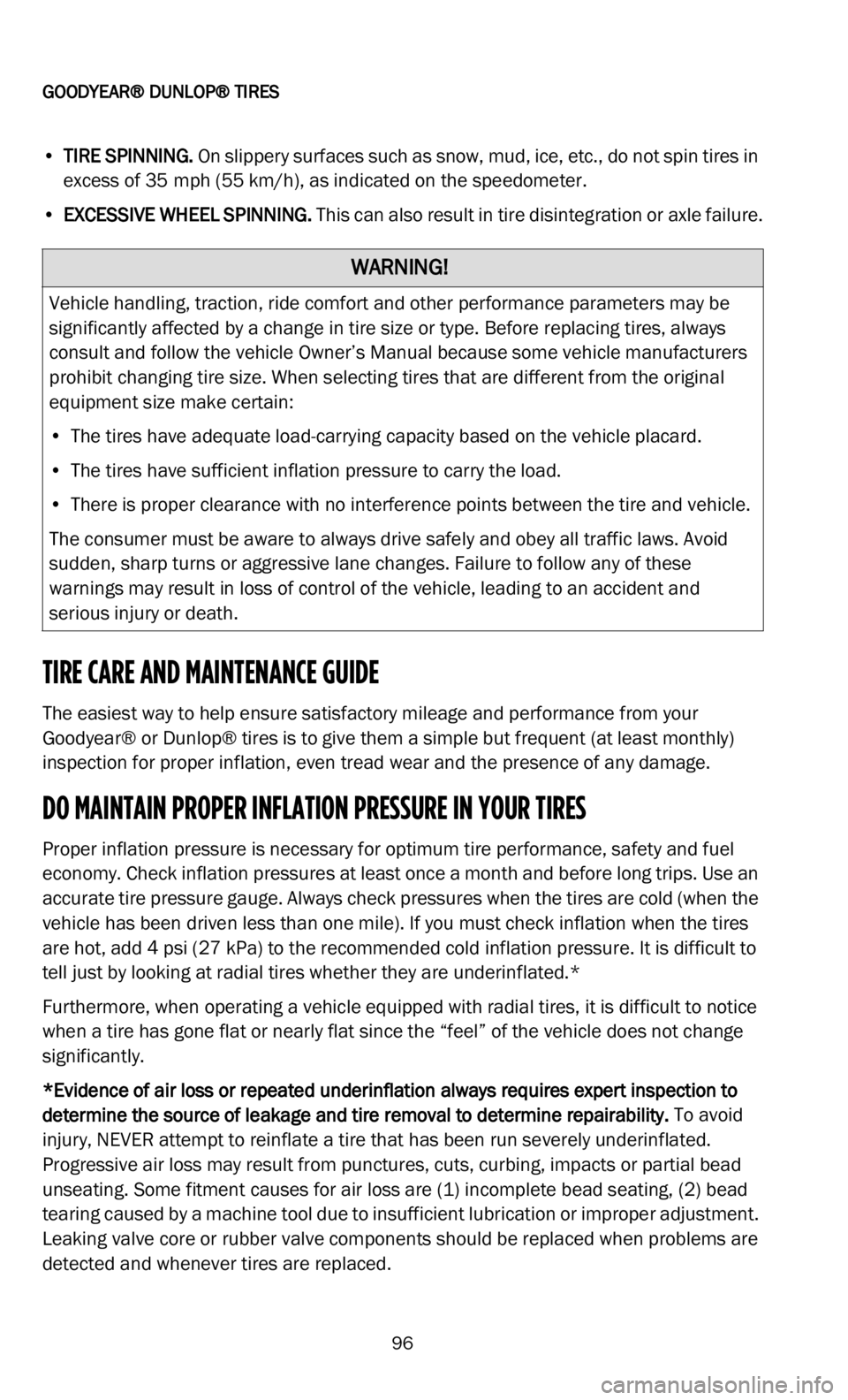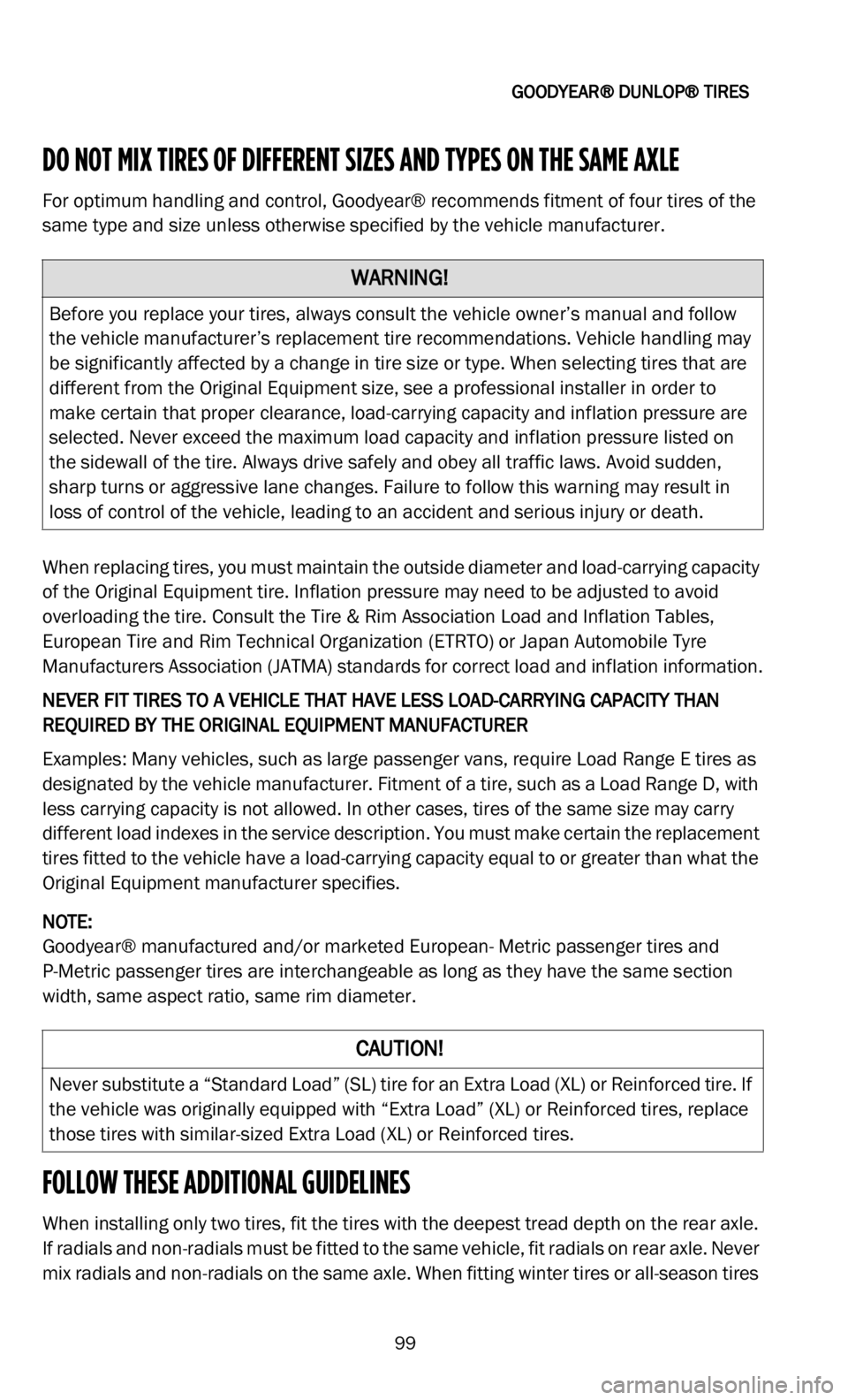DODGE DURANGO 2022 Vehicle Warranty
Manufacturer: DODGE, Model Year: 2022, Model line: DURANGO, Model: DODGE DURANGO 2022Pages: 200, PDF Size: 6.72 MB
Page 91 of 200

GENERAL TIRE
90
(“Authorized Dealer”). CTNA will replace the tire pursuant to the terms of this Limited
Warranty and Adjustment Policy. Tires that are replaced under an adjustment basis
under this Limited Warranty and Adjustment Policy become the property of CTNA.
OWNER’S OBLIGATIONS
To make an eligible claim under this Limited Warranty and Adjustment Policy, the owner
must present a claim with the tire to an authorized dealer. For the nearest authorized
dealer, consult the Yellow Pages, the General brand internet address, or the 800 telephone
numbers shown on the back of this Limited Warranty and Adjustment Policy. Owner must
present new vehicle registration form or new vehicle sales invoice indicating the date of
purchase. Owner will be required to sign the CTNA Limited Warranty Claim Form or dealer
replacement sales receipt.
Owner is responsible for paying all applicable taxes set forth under this Limited Warranty
and
Adjustment Policy. Owner is also responsible for paying local tire disposal fees and any
parts or service regardless of mileage or months of service. This includes payment for tire
rotation, alignment, towing, road service, valve stems and tire repairs. Owner is
responsible for maintaining proper tire air pressure and for proper maintenance of the tire.
SAFETY WARNING:
Ignoring any of the safety and information contained in this limited warranty and
Adjustment Policy may result in tire failure, causing serious injury or death.
• Tire failure due to underinflation/overloading.
Follow vehicle Owner’s Manual or tire
placard in vehicle for proper inflation and loading.
• Explosion of tire/rim assembly due to improper tire mounting.
Tire mounting /
demounting can be dangerous. It should be performed only by a trained tire specialist
using proper tools and procedures. Prior to tire mounting/demounting, the Rubber
Manufacturers Association (RMA) wall charts and manuals should be read to obtain
the proper procedures. The failure to follow these procedures may result in faulty posi -
tioning of the tire and/or rim, which may cause the assembly to burst with force suffi -
cient to cause injury or death.
• T
ire failure due to damage.
Inspect your tires frequently for scrapes, bulges, separations,
cuts, snags and other damage from road hazards. Damage from impact can occur to the
inner portions of your tire without being visible to the outside. If you suspect a tire has
been damaged from striking anything unusual in the road, you must have the tire
removed from the rim and inspected both inside and out by a trained tire specialist. Air
loss or unusual tire wear can also be warning signs that a tire may have internal damage.
If you notice these conditions, have your tire inspected by a trained individual.
• Tire failure due to excessive tire spinning.
Avoid tire spinning. The centrifugal force
generated by a free-spinning tire/rim assembly may cause a sudden tire explosion
resulting in vehicle damage and/or serious injury or death. Never exceed 35 mph
( 5
5 km/h) as indicated on your speedometer when your vehicle is stuck in snow, mud,
o r
sand and your tire(s) is/are spinning. Use a gentle backward and forward rocking
motion to free your vehicle for continued driving. Never stand or permit anyone else to
stand near or behind a tire spinning while attempting to push a vehicle that is stuck.
Page 92 of 200

GENERAL TIRE
91
TEMPORARY SPARE TIRE OWNERS
CTNA does not recommend any repair to or reuse of punctured Temporary Spare Tires.
In addition to the valuable warranty, safety and maintenance information you will find in
t h
is Limited Warranty and Adjustment Policy we encourage you to visit General Tire
Brand websites at: http://generaltire.custhelp.com/ or ( www.generaltire.ca) for
up-to-date changes and a Self-Help knowledge base with downloadable brochures
( c
ustomer care link). Please also visit the US Tire Manufacturer Association (USTMA)
website at https://www.ustires.org/ .
THIS LIMITED WARRANTY AND ADJUSTMENT POLICY IS NOT A WARRANTY THAT YOUR
T I
RE WILL NOT FAIL OR BECOME UNSERVICEABLE IF NEGLECTED OR MISTREATED.
FOR SERVICE ASSISTANCE OR INFORMATION
First, contact the nearest General brand tire dealer. For the nearest General brand tire
dealer, consult the Yellow Pages or, if for any reason local service or information is not
available, call one of General brand toll-free Customer Relations numbers:
In the United States, call 1 -
800-847-3349
In Canada, call 1 -
800-461-1776
CTNA, Inc. 1830 MacMillan Park Dr. Fort Mill, SC 29707
CT Canada Inc. 6110 Cantay Rd. Mississauga, ON L5R 3W5
Page 93 of 200

92
GOODYEAR® DUNLOP® TIRES
HIGHWAY AUTO AND LIGHT TRUCK TIRE WARRANTY AND ADJUSTMENT POLICY
(EXCLUDES GOODYEAR® UNISTEEL® RADIAL LIGHT TRUCK TIRES)
WHO IS ELIGIBLE
You are eligible for the benefits of this Limited Warranty if you meet all the following
criteria:
• You are the owner or authorized agent of the owner of new Goodyear® or Dunlop® hi
ghway auto or light truck tires supplied as original equipment on your vehicle.
• Your tires bear Department of Transportation (DOT) prescribed tire identification nu
mbers.
• Your tires have been used only on the vehicle on which they were originally installed ac
cording to the vehicle manufacturer’s or Goodyear’s® recommendations.
• Your tires were purchased on or after March 1, 2014.
Li g
ht truck tires are defined as all tires identified with the “LT” designation in the sidewall
st a
mping.
WHAT IS COVERED AND FOR HOW LONG
FREE TIRE REPLACEMENT
Any new Goodyear® or Dunlop® highway radial auto or radial light truck tire, covered by
this policy, removed from service due to a covered warranty condition during the first
2/32 of an inch of usable tread or 12 months from date of purchase, whichever comes
f ir
st, will be replaced with a comparable new Goodyear® or Dunlop® tire at no charge,
including mounting and balancing. Without proof of purchase the date of manufacture
will be used to determine eligibility.
ALL OTHER HIGHWAY AUTO OR LIGHT TRUCK TIRES
Any new Goodyear® or Dunlop® highway auto or light truck tire, other than radial auto
or radial light truck tires, removed from service due to a covered warranty condition
during the first 1/32" of usable tread will be replaced with a comparable new Goodyear®
or Dunlop® tire at no charge, including mounting and balancing.
TEMPORARY SPARE TIRES
Any Goodyear® or Dunlop® temporary spare tire removed from service due to a covered
warranty condition during the first 50% of usable tread wear (1/32 of an inch) will be
replaced with a comparable new Goodyear® or Dunlop® temporary spare tire at no
charge, including mounting.
Page 94 of 200

GOODYEAR® DUNLOP® TIRES
93
PRORATED ADJUSTMENT
Tires not eligible for free replacement that are removed from service due to a covered
warranty condition will be replaced with a comparable new Goodyear® or Dunlop® tire
on a prorated basis for up to six years from the date of original new tire purchase or when
the treadwear indicators become visible (worn to 2/32 of an inch), whichever occurs
first. Without proof of purchase the date of manufacture will be used to determine
eligibility.
HOW WILL PRORATED CHARGES BE CALCULATED
Replacement price will be calculated by multiplying the tire’s advertised retail selling
price at the time of adjustment by the percentage of usable original tread that has been
worn off. You pay for mounting and balancing, and an amount equal to the current
Federal Excise Tax (FET) – US only, and any other applicable taxes and
government-mandated charges.
EXAMPLE: If your disabled tire had an original 8/32 of an inch of usable tread wear and
i
s worn to 4/32 of an inch usable tread remaining, you have used 50% and therefore
must pay 50% of the advertised retail selling price of the comparable tire.
In addition, you must pay an amount equal to the full current FET (US only) or any other
a p
plicable taxes and government-mandated charges for the comparable new
replacement tire at the time of adjustment. If the price of the new comparable tire is
$130.00, the cost to you would be $65.00 plus FET (US only) plus any other applicable
taxes and government-mandated charges.
WHAT IS A COMPARABLE TIRE?
A “comparable” new Goodyear® or Dunlop® tire will be the same brand tire and may be
either the same line of tire or, in the event that the tire is not available, the same brand
tire with the same basic construction and similar performance attributes with a different
sidewall or tread configuration. If a higher priced tire is accepted as replacement, the
difference in price will be at an additional charge to you. Any replacement tire provided
pursuant to this warranty will be covered by the warranty in effect at the time of
replacement.
ADDITIONAL PROVISIONS
A tire has delivered its full original tread life and the coverage of this limited warranty
ends when the tread wear indicators become visible (worn to 2/32 of an inch) or six years
from the date of new tire purchase, whichever occurs first. Without proof of purchase the
date of manufacture will be used to determine eligibility.
LIMITATIONS
This limited warranty is applicable only in the United States and Canada.
Page 95 of 200

GOODYEAR® DUNLOP® TIRES
94
WHAT IS NOT COVERED BY THIS WARRANTY?
This limited warranty does not cover the following:
• Tires submitted for ride disturbance complaints that are worn beyond the first 2/32 of
a
n inch tread depth or tires submitted for ride disturbance due to damaged wheels or
any vehicle condition.
• G oodyear® does not warrant or give credit in any adjustment transaction for any kind
o
f material added to a tire (e.g., tire fillers, sealants, balancing substances) after the
tire leaves a factory producing Goodyear® or Dunlop® tires, nor will it adjust any tire
that has failed as a result of adding such material.
• I rregular wear or damage due to mechanical condition of the vehicle, improper infla -
t
ion, overloading, high speed spin-up, misapplication, misuse, negligence, racing, use
o f
tire chains, improper mounting or demounting, improper repair, wreck, collision or
fire.
• R oad hazards (includes, but is not limited to, punctures, cuts, snags, impact breaks,
e
tc.).
• A ny tire that, after leaving a factory producing Goodyear® or Dunlop® tires, has been
i
ntentionally altered to change its appearance (e.g., white inlay on a black tire or
regrooved).
• T ires with weather-cracking that were purchased more than four years prior to presen -
t
ation for adjustment or, if purchase date cannot be verified, manufactured more than
f o
ur years prior to presentation for adjustment.
• T emporary spare tires used on vehicles used in racing and on passenger cars in
s
pecial applications such as police pursuit service.
• G oodyear® Unisteel® Commercial Radial Light Truck Tires.
•
Tires removed from service due to improper repairs.
•
Tires supplied as Original Equipment are not eligible for any tread life warranty consid -
e
ration.
• C osmetic weather checking.
•
Tire Pressure Monitoring System (TPMS) – refer to vehicle manufacturer’s warranty.
•
Ultra High-Performance Summer tires are not recommended for Winter use, and tread
o
r shoulder cracking on those tires resulting from Winter use will not be covered under
our warranty.
WHAT ARE YOUR LEGAL RIGHTS?
No Representative or dealer has authority to make any representation, promise or
agreement on behalf of Goodyear®, except as stated herein. Any tire, no matter how well
constructed, may fail in service or otherwise become unserviceable due to conditions
beyond the control of the manufacturer. Under no circumstances is this warranty a
representation that a tire failure cannot occur.
DISCLAIMER: THIS WARRANTY IS IN LIEU OF, AND GOODYEAR® HEREBY DISCLAIMS,
AN
Y AND ALL OTHER WARRANTIES AND REPRESENTATIONS, EXPRESS OR IMPLIED,
Page 96 of 200

GOODYEAR® DUNLOP® TIRES
95
INCLUDING WITHOUT LIMITATION ANY WARRANTY OF MERCHANTABILITY OR FITNESS
FOR A PARTICULAR PURPOSE, AND NO OTHER WARRANTY OR REPRESENTATION OF ANY
KIND IS MADE BY GOODYEAR® OR SHALL BE IMPLIED BY LAW.
LIMITATION OF DAMAGES: IN NO EVENT AND UNDER NO CIRCUMSTANCE SHALL
G O
ODYEAR® BE LIABLE TO THE BUYER FOR ANY INDIRECT, SPECIAL, INCIDENTAL,
CONSEQUENTIAL, LOST PROFIT, LOSS OF BUSINESS, LOSS OF GOODWILL OR
REPUTATION, PUNITIVE OR OTHER DAMAGE, COST (INCLUDING FOR REPLACEMENT
TRANSPORTATION), EXPENSE OR LOSS OF ANY KIND. SOME STATES AND PROVINCES
DO NOT ALLOW THE EXCLUSION OR LIMITATION OF INCIDENTAL OR CONSEQUENTIAL
DAMAGES, SO THE ABOVE LIMITATION OR EXCLUSION MAY NOT APPLY TO YOU.
This warranty gives you specific legal rights and you may also have other rights that vary
f r
om state to state or province to province.
HOW DO YOU OBTAIN AN ADJUSTMENT?
1. You must present the tire to be adjusted to an authorized Goodyear® or Dunlop® service facility. Tires replaced on an adjustment basis become the property of The
Goodyear® Tire & Rubber Company or Goodyear® Canada Inc.
2. Y ou must pay for taxes and any additional services you order at the time of adjust -
m
ent plus any additional service that may be unique to your application, e.g., Tire
P r
essure Monitoring System (TPMS).
3. Y ou must submit your claim on an approved claim form supplied by an authorized
G
oodyear® or Dunlop® service facility. The form must be filled out completely and
signed, where you the owner or an authorized agent presented the tire for adjust -
ment. You must go to an authorized Goodyear® or Dunlop® outlet for replacement
t i
res and all warranty service.
SAFETY WARNINGS
Property damage, serious injury or death may result from:
• TIRE FAILURE DUE TO UNDERINFLATION/OVERLOADING/ MISAPPLICATION.
Follow
the vehicle Owner’s Manual or tire placard in vehicle.
• TIRE FAILURE DUE TO IMPACT DAMAGE/IMPROPER MAINTENANCE.
Tires should be
inspected regularly by a qualified technician for signs of damage, such as punctures
or impacts.
• TIRE FAILURE DUE TO IMPROPER REPAIRS. See US Tire Manufactuers Association
(
USTMA) established repair procedures at https://www.ustires.org/ and/or go to
www.goodyear.com for information on proper repair procedures.
• EXPLOSION OF TIRE/RIM ASSEMBLY DUE TO IMPROPER MOUNTING.
Only specially
trained persons should mount tires.
• FAILURE TO MOUNT RADIAL TIRES ON APPROVED RIMS.
• FAILURE TO DEFLATE SINGLE OR DUAL ASSEMBLIES COMPLETELY BEFORE
D
EMOUNTING.
Page 97 of 200

GOODYEAR® DUNLOP® TIRES
96
•TIRE SPINNING. On slippery surfaces such as snow, mud, ice, etc., do not spin tires in
excess of 35 mph (55 km/h), as indicated on the speedometer.
• EXCESSIVE WHEEL SPINNING.
This can also result in tire disintegration or axle failure.
TIRE CARE AND MAINTENANCE GUIDE
The easiest way to help ensure satisfactory mileage and performance from your
Goodyear® or Dunlop® tires is to give them a simple but frequent (at least monthly)
inspection for proper inflation, even tread wear and the presence of any damage.
DO MAINTAIN PROPER INFLATION PRESSURE IN YOUR TIRES
Proper inflation pressure is necessary for optimum tire performance, safety and fuel
economy. Check inflation pressures at least once a month and before long trips. Use an
accurate tire pressure gauge. Always check pressures when the tires are cold (when the
vehicle has been driven less than one mile). If you must check inflation when the tires
are hot, add 4 psi (27 kPa) to the recommended cold inflation pressure. It is difficult to
tell just by looking at radial tires whether they are underinflated.*
Furthermore, when operating a vehicle equipped with radial tires, it is difficult to notice
wh
en a tire has gone flat or nearly flat since the “feel” of the vehicle does not change
significantly.
*Evidence of air loss or repeated underinflation always requires expert inspection to
d e
termine the source of leakage and tire removal to determine repairability. To avoid
injury, NEVER attempt to reinflate a tire that has been run severely underinflated.
Progressive air loss may result from punctures, cuts, curbing, impacts or partial bead
unseating. Some fitment causes for air loss are (1) incomplete bead seating, (2) bead
tearing caused by a machine tool due to insufficient lubrication or improper adjustment.
Leaking valve core or rubber valve components should be replaced when problems are
detected and whenever tires are replaced.
WARNING!
Vehicle handling, traction, ride comfort and other performance parameters may be
significantly affected by a change in tire size or type. Before replacing tires, always
consult and follow the vehicle Owner’s Manual because some vehicle manufacturers
prohibit changing tire size. When selecting tires that are different from the original
equipment size make certain:
• The tires have adequate load-carrying capacity based on the vehicle placard.
•
The tires have sufficient inflation pressure to carry the load.
•
There is proper clearance with no interference points between the tire and vehicle.
T
he consumer must be aware to always drive safely and obey all traffic laws. Avoid
s u
dden, sharp turns or aggressive lane changes. Failure to follow any of these
warnings may result in loss of control of the vehicle, leading to an accident and
serious injury or death.
Page 98 of 200

GOODYEAR® DUNLOP® TIRES
97
Always maintain inflation pressure at the level recommended by the vehicle
manufacturer as shown on the vehicle placard, vehicle certification label or in the vehicle
Owner’s Manual:
Underinflation is the leading cause of tire failure and may result in severe cracking,
c o
mponent separation or “blowout.” It reduces tire load capacity, allows excessive
sidewall flexing and increases rolling resistance, resulting in heat and mechanical
damage. Maintaining proper inflation pressure is the single most important thing you can
do to promote tire durability and maximize tread life.
Overinflation increases stiffness, which may deteriorate ride and generate unwanted
vi
bration. Overinflation also increases the chances of impact damage.
DON’T OVERLOAD YOUR VEHICLE
Check your vehicle Owner’s Manual to determine the load limits. Overloading your vehicle
places stress on your tires and other critical vehicle components. Overloading a vehicle can
cause poor handling or increased fuel consumption and may cause tire failure. Overloading
your tires can result in severe cracking, component separation or “blowout.”
Never fit your vehicle with new tires that have less load capacity than shown on the
ve
hicle tire placard and remember that optimum rim width is important for proper tire
load distribution and function. The maximum load capacity stamped on the sidewalls of
P-Metric & European Metric tires is reduced by 10% when used on a light truck, utility
vehicle or trailer. Never fit P-Metric or European Metric tires to light trucks that specify
LT-type replacement tires.
DO NOT SPIN YOUR TIRES EXCESSIVELY
Avoid excessive tire spinning when your vehicle is stuck in snow, ice, mud or sand. The
centrifugal forces generated by a free-spinning tire/wheel assembly may cause sudden
tire explosion, resulting in vehicle damage and/or serious personal injury to you or a
bystander. Never exceed 35 mph (55 km/h), as indicated on your speedometer. Use a
g e
ntle backward and forward rocking motion to free your vehicle for continued driving.
Never stand near or behind a tire spinning at high speeds, for example, while attempting
to push a vehicle that is stuck or when an on-the-car spin balance machine is in use.
DO CHECK YOUR TIRES FOR WEAR
Always remove tires from service when they reach 2/32 of an inch remaining tread
depth. All new tires have tread wear indicators which appear as smooth banks in the
tread grooves when they wear to the 2/32 of an inch level. Many wet weather accidents
result from skidding on bald or nearly bald tires. Excessively worn tires are also more
susceptible to penetrations.
Page 99 of 200

GOODYEAR® DUNLOP® TIRES
98
DO CHECK YOUR TIRES FOR DAMAGE
Frequent (at least monthly) inspection of your tires for signs of damage and their general
condition is important for safety. If you have any questions, have your tire dealer inspect
them. Impacts, penetrations, cracks, knots, bulges or air loss always require tire removal
and expert inspection. Never perform a temporary repair or use an inner tube as a
substitute for a proper repair. Only qualified persons should repair tires.
PROPER TIRE REPAIR
Goodyear® does not warrant any inspection or repair process. The repair is entirely the
responsibility of the repairer and should be made in accordance with established Rubber
Manufacturers Association (RMA) procedures.
Tire Pressure Monitoring System (TPMS) Alert
Refer to your vehicle Owner’s Manual for more information on what to do if the Tire
Pressure Monitoring System (TPMS) alert activates.
THE CONVENIENCE (TEMPORARY) SPARE
The Convenience (Temporary) Spare is designed, built and tested to the high engineering
standards set by North America’s leading car manufacturers and to Goodyear®’s own
high standards of quality control. It is designed to take up minimum storage space and,
at the same time, fulfill the function of a spare tire when needed. The spare is kept in its
storage space, fully inflated at 60 psi. To be sure it is always ready for use, the air
pressure should be checked on a regular basis.
The Convenience (Temporary) Spare can be used in combination with the original tires
on
your vehicle. You can expect a tire tread life of up to 3,000 miles (4,800 kilometers),
d e
pending on road conditions and your driving habits. To conserve tire tread life, return
the spare to the storage area as soon as it is convenient to have the standard tire
repaired or replaced.
The Convenience (Temporary) Spare weighs less than a standard tire so it’s easier to
h a
ndle. It also helps reduce the total car weight, which contributes to fuel economy. The
wheels used with the Convenience (Temporary) Spare are specifically designed for use
with high pressure spares and should never be used with any other type tire.
DO NOT ATTEMPT TO MOUNT YOUR OWN TIRES
Serious injury or death may result from explosion of tire/rim assembly due to improper
mounting procedures. Follow tire manufacturer’s instructions and match tire diameter to
rim diameter. Mount light truck radials on rims approved for radial service. Do not apply
bead sealer. This can inhibit bead seating. Lubricate beads and tire rim (including tube
or flap) contact surfaces. Lock assembly on mounting machine or place in safety cage.
STAND BACK and never exceed 40 psi to seat beads. Never use a volatile substance or
a rubber “donut” (also known as a bead expander or “O-Ring”) to aid bead seating. Only
specially trained persons should mount tires.
Page 100 of 200

GOODYEAR® DUNLOP® TIRES
99
DO NOT MIX TIRES OF DIFFERENT SIZES AND TYPES ON THE SAME AXLE
For optimum handling and control, Goodyear® recommends fitment of four tires of the
same type and size unless otherwise specified by the vehicle manufacturer.
When replacing tires, you must maintain the outside diameter and load-carrying capacity
of
the Original Equipment tire. Inflation pressure may need to be adjusted to avoid
overloading the tire. Consult the Tire & Rim Association Load and Inflation Tables,
European Tire and Rim Technical Organization (ETRTO) or Japan Automobile Tyre
Manufacturers Association (JATMA) standards for correct load and inflation information.
NEVER FIT TIRES TO A VEHICLE THAT HAVE LESS LOAD-CARRYING CAPACITY THAN
RE
QUIRED BY THE ORIGINAL EQUIPMENT MANUFACTURER
Examples: Many vehicles, such as large passenger vans, require Load Range E tires as
d e
signated by the vehicle manufacturer. Fitment of a tire, such as a Load Range D, with
less carrying capacity is not allowed. In other cases, tires of the same size may carry
different load indexes in the service description. You must make certain the replacement
tires fitted to the vehicle have a load-carrying capacity equal to or greater than what the
Original Equipment manufacturer specifies.
NOTE:
Goodyear® manufactured and/or marketed European- Metric passenger tires and
P -
Metric passenger tires are interchangeable as long as they have the same section
width, same aspect ratio, same rim diameter.
FOLLOW THESE ADDITIONAL GUIDELINES
When installing only two tires, fit the tires with the deepest tread depth on the rear axle.
If radials and non-radials must be fitted to the same vehicle, fit radials on rear axle. Never
mix radials and non-radials on the same axle. When fitting winter tires or all-season tires
WARNING!
Before you replace your tires, always consult the vehicle owner’s manual and follow
the vehicle manufacturer’s replacement tire recommendations. Vehicle handling may
be significantly affected by a change in tire size or type. When selecting tires that are
different from the Original Equipment size, see a professional installer in order to
make certain that proper clearance, load-carrying capacity and inflation pressure are
selected. Never exceed the maximum load capacity and inflation pressure listed on
the sidewall of the tire. Always drive safely and obey all traffic laws. Avoid sudden,
sharp turns or aggressive lane changes. Failure to follow this warning may result in
loss of control of the vehicle, leading to an accident and serious injury or death.
CAUTION!
Never substitute a “Standard Load” (SL) tire for an Extra Load (XL) or Reinforced tire. If
the vehicle was originally equipped with “Extra Load” (XL) or Reinforced tires, replace
those tires with similar-sized Extra Load (XL) or Reinforced tires.